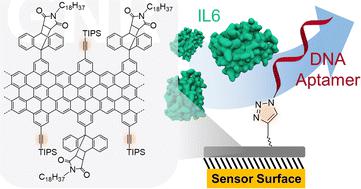当前位置:
X-MOL 学术
›
Nanoscale Horiz.
›
论文详情
Our official English website, www.x-mol.net, welcomes your feedback! (Note: you will need to create a separate account there.)
“Clickable” graphene nanoribbons for biosensor interfaces
Nanoscale Horizons ( IF 9.7 ) Pub Date : 2024-02-22 , DOI: 10.1039/d3nh00590a Roger Hasler 1, 2 , Gonzalo E. Fenoy 1, 3 , Alicia Götz 4 , Verónica Montes-García 5 , Cataldo Valentini 5, 6 , Zijie Qiu 4, 7 , Christoph Kleber 2 , Paolo Samorì 5 , Klaus Müllen 4 , Wolfgang Knoll 1, 2
Nanoscale Horizons ( IF 9.7 ) Pub Date : 2024-02-22 , DOI: 10.1039/d3nh00590a Roger Hasler 1, 2 , Gonzalo E. Fenoy 1, 3 , Alicia Götz 4 , Verónica Montes-García 5 , Cataldo Valentini 5, 6 , Zijie Qiu 4, 7 , Christoph Kleber 2 , Paolo Samorì 5 , Klaus Müllen 4 , Wolfgang Knoll 1, 2
Affiliation

|
We report on the synthesis of “clickable” graphene nanoribbons (GNRs) and their application as a versatile interface for electrochemical biosensors. GNRs are successfully deposited on gold-coated working electrodes and serve as a platform for the covalent anchoring of a bioreceptor (i.e., a DNA aptamer), enabling selective and sensitive detection of Interleukin 6 (IL6). Moreover, when applied as the intermediate linker on reduced graphene oxide (rGO)-based field-effect transistors (FETs), the GNRs provide improved robustness compared to conventional aromatic bi-functional linker molecules. GNRs enable an orthogonal and covalent attachment of a recognition unit with a considerably higher probe density than previously established methods. Interestingly, we demonstrate that GNRs introduce photoluminescence (PL) when applied to rGO-based FETs, paving the way toward the simultaneous optical and electronic probing of the attached biointerface.
中文翻译:

用于生物传感器接口的“可点击”石墨烯纳米带
我们报告了“可点击”石墨烯纳米带(GNR)的合成及其作为电化学生物传感器的多功能接口的应用。GNR 成功沉积在镀金工作电极上,并作为生物受体(即DNA 适体)共价锚定的平台,从而能够选择性且灵敏地检测白细胞介素 6 (IL6)。此外,当用作基于还原氧化石墨烯(rGO)的场效应晶体管(FET)上的中间连接体时,与传统的芳香族双功能连接体分子相比,GNR 提供了更高的鲁棒性。GNR 能够以比以前建立的方法高得多的探针密度实现识别单元的正交和共价连接。有趣的是,我们证明 GNR 在应用于基于 rGO 的 FET 时会引入光致发光(PL),为同时对所连接的生物界面进行光学和电子探测铺平了道路。
更新日期:2024-02-22
中文翻译:

用于生物传感器接口的“可点击”石墨烯纳米带
我们报告了“可点击”石墨烯纳米带(GNR)的合成及其作为电化学生物传感器的多功能接口的应用。GNR 成功沉积在镀金工作电极上,并作为生物受体(即DNA 适体)共价锚定的平台,从而能够选择性且灵敏地检测白细胞介素 6 (IL6)。此外,当用作基于还原氧化石墨烯(rGO)的场效应晶体管(FET)上的中间连接体时,与传统的芳香族双功能连接体分子相比,GNR 提供了更高的鲁棒性。GNR 能够以比以前建立的方法高得多的探针密度实现识别单元的正交和共价连接。有趣的是,我们证明 GNR 在应用于基于 rGO 的 FET 时会引入光致发光(PL),为同时对所连接的生物界面进行光学和电子探测铺平了道路。



























 京公网安备 11010802027423号
京公网安备 11010802027423号